>>> Research: Whole-Body Surface Anthropometry
Measuring and Modeling Whole-Body Surface Shape

The conduct of anthropometric surveys has changed substantially in recent years due to the availability of whole-body scanners that can capture three-dimensional body shape. Our lab at UMTRI uses a Vitus XXL whole-body laser scanner for an ongoing series of studies. Our database of scans now includes more than 15000 scans from hundreds of people in many poses with a range of garb. Our major focus has been on body shape in supported seated postures, for vehicle and seat design applications, but we also have gathered data in standing postures and developed parametric human body models for ergonomic analysis.
Parametric Model of Child Body Shape in Standing Postures
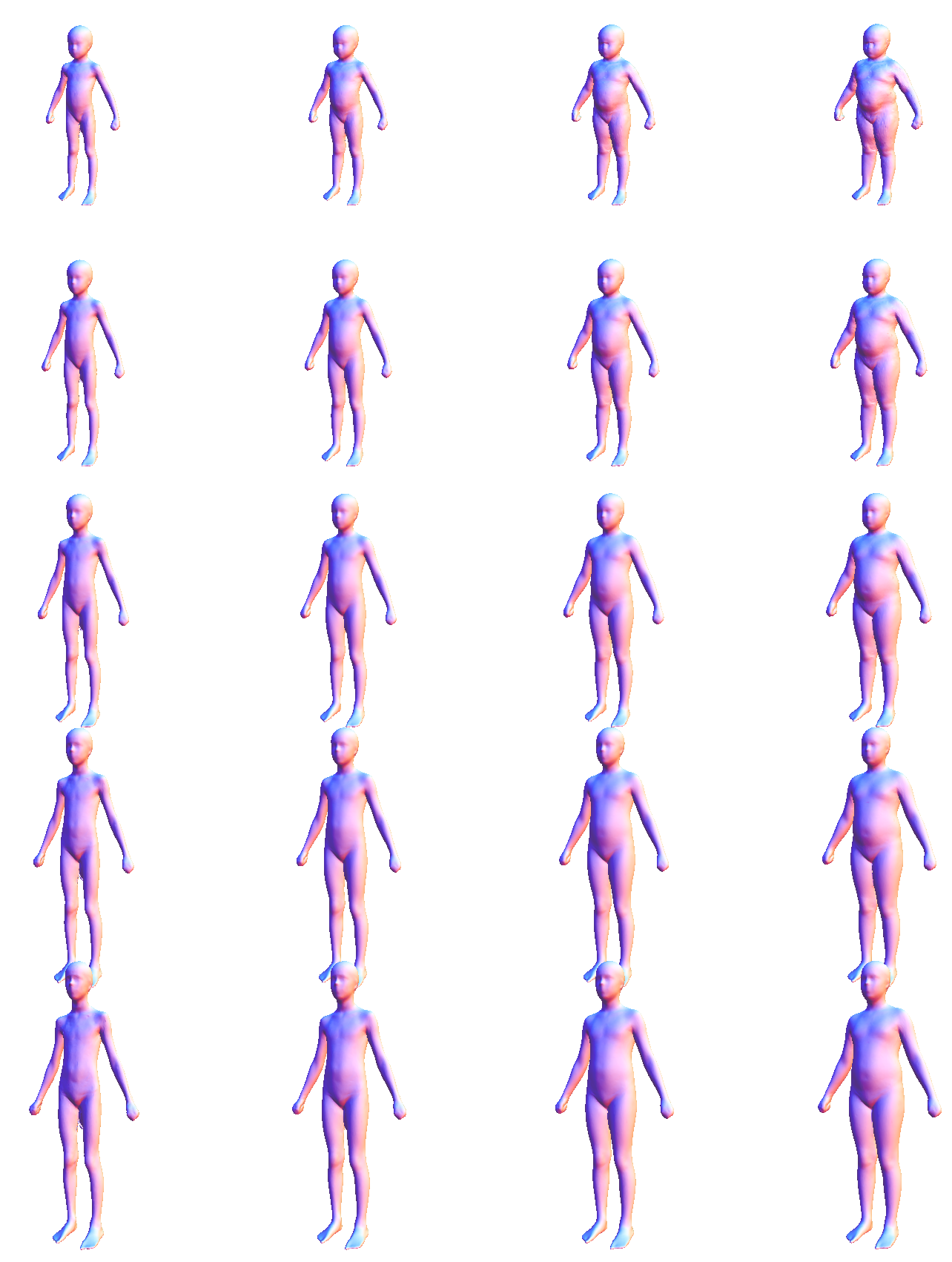
We used laser-scan data from 140 children ages 4 to 11 to create a parametric model of body size and shape for standing children. We can input standard anthropometric dimensions, such as stature and body weight, and obtain the mean expected body shape. The model will have extensive application for the development of parametric human body models and for ergonomic applications, including the design of clothing and protective equipment. The image to the right shows the model exercised over the range of stature and BMI in the input data. The high-resolution model is based on a template with 30k vertices. The model includes prediction of over 80 surface landmarks and internal joint centers defining the skeletal linkage.The PCA+regression methodology provides a flexible system that can generate predicted body shapes for a wide range of inputs.
Parametric Model of Male Body Shape in Supported Seated Postures
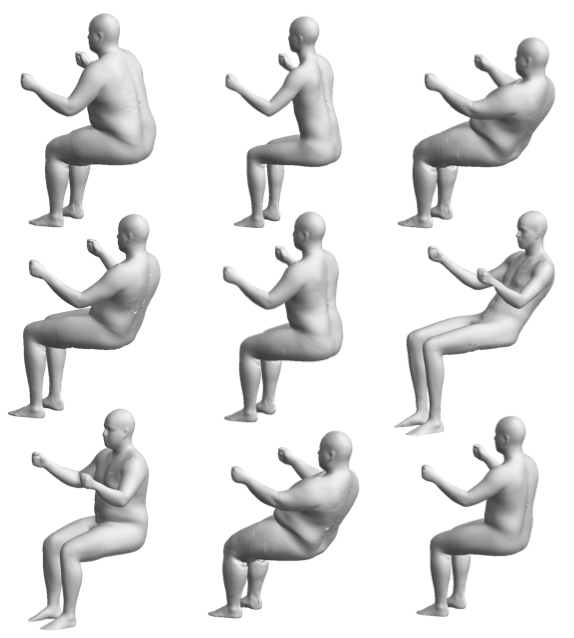
A major focus of our human modeling research is the accurate representation of body shape in supported seated postures. We have developed techniques for measuring postures that span the range expected in vehicle and other seating environments. The images to the right were generated using a model based on 338 scans from 126 men (up to 4 postures per subject). The model is capable of producing accurate representations of body shape for a wide range of recline angles, from upright to highly reclined, and a range of lumbar spine flexions. The body sizes for the input data more than 95 percent of the US population by both stature and body weight. This model has broad applications in the design of seated workspaces, seats, chairs, and equipment designed for seated workers.
Parametric Models of Male and Female Adult Body Shape in Standing Postures

Several other research groups have created parametric models of standing body shapes. Ours are unusual in that they include a large number of surface landmarks and internal joint centers that can make them more useful for engineering applications. Our modeling procedures are also designed to be template-agnostic, so that we can fairly quickly generate a model with equivalent functionality on a different mesh. The versions of the male and female models shown here were created on the meshes used by the Jack human figure model from Siemens to facilitate implementation in that software. This version takes 11 anthropometric variables (stature, body weight, erect sitting height, etc.) as input, along with age
Body Shapes of Older Adults

As part of a recent study of driver and passenger posture, we scanned 200 men and women in 18 standing and seated postures. Unlike most previous scanning studies of US adults, 2/3 of this sample was age 60 or older, providing a quantitative picture of body shapes of both younger and older men and women. The statistical models resulting from this study show quantitatively how older adults' body shapes differ from those of younger people after accounting for typical age-related changes like loss of stature and increase in body weight. These models have broad applicability, particular in the design of clothing and protective equipment.
Soldier Body Shapes: Effects of Body Armor and Body-Borne Gear
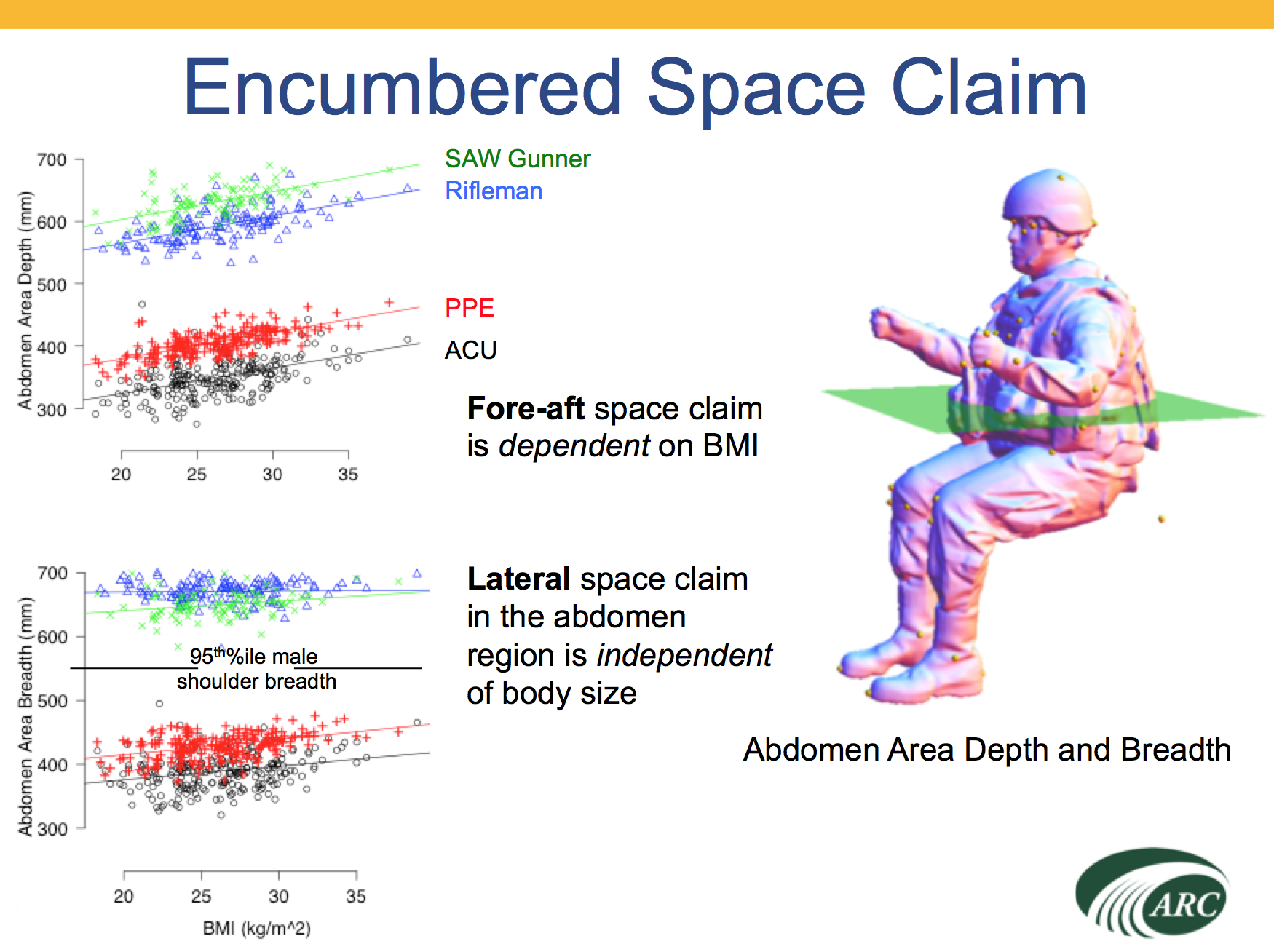
As part of our Seated Soldier Study, conducted with funding from the U.S. Army through the Automotive Research Center at the University of Michigan, we partnered with Anthrotech to scan 257 male soldiers and 53 female soldiers in a wide range of postures. In our civilian studies, the participants are scanned minimally clad so that we can accurately capture their body shape. In the soldier study, we also scanned the participants wearing their uniforms and with body armor and a typical set of body-borne gear. These scans provide a rich dataset for the design of military vehicles. In particular, the data provide quantitative guidance on space requirements for soldiers in both standing and seated postures.
Modeling Torso Shapes for Chair and Seat Design
The design of chairs and seats has been hampered by a lack of detailed anthropometric data directly relevant to the design problem. Traditional lengths, widths, and circumferences are not very useful for constructing three-dimensional surfaces intended to provide comfortable support for a wide range of the design population.
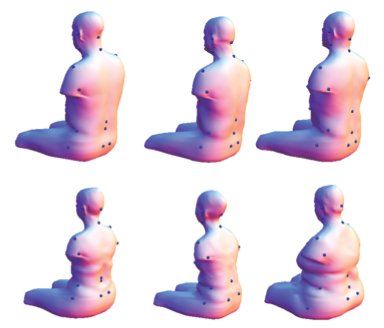
I've done many body surfaces analyses for Herman MIller, a major office furniture manufacturer. I've developed software to extract the torso data from the scan files and to articulate the torso with smooth surface deformation. Using principal component analysis and multivariate regression, I've created a statistical model that generates torso shapes based on overall anthropometric variables, such as gender, stature, and body weight. Herman Miller uses the tools developed from these analyses to improve their office chair designs.
The figure to the left shows some of the torso models developed by this methdology. Each torso shape is representated by a homologous mesh that can be analyzed to extract desired dimensions (for example surface profiles corresponding to particular anatomical locations) or to calculate distances along the surface. The PCA+regression analysis allows a torso shape to be predicted for any desired combination of body dimensions. For example, various combinations of stature and body mass index (BMI) can be specified for both men and women to obtain boundary cases for use in seat design.

The figure to the right shows the result of exercising the model female torsos. Stature was held constant at a typical median female value while body mass index was varied from 18 to 45. The model shows the average effects of BMI on female body shape. The results can be used to assess the fit and accommodation of chairs, seats, clothing, protective equipment, and other products and facilities designed to be used by a wide range of individuals.
Modeling Posture Change
The male and female torso body shape models described above characterize body shape in the scanned posture, but often the design posture is different from the scanned posture. Using a skeletal linkage fit to the inside of the body scans, a statistical model that includes the effects of posture change was created. The images to the left and below show the effects of modifying both body mass index and seated posture over a wide range typical of automotive applications. The model illustrated here is used to conduct virtual seat fit assessments and has applications to the development of finite-element models for assessing the performance of occupant restraint systems. 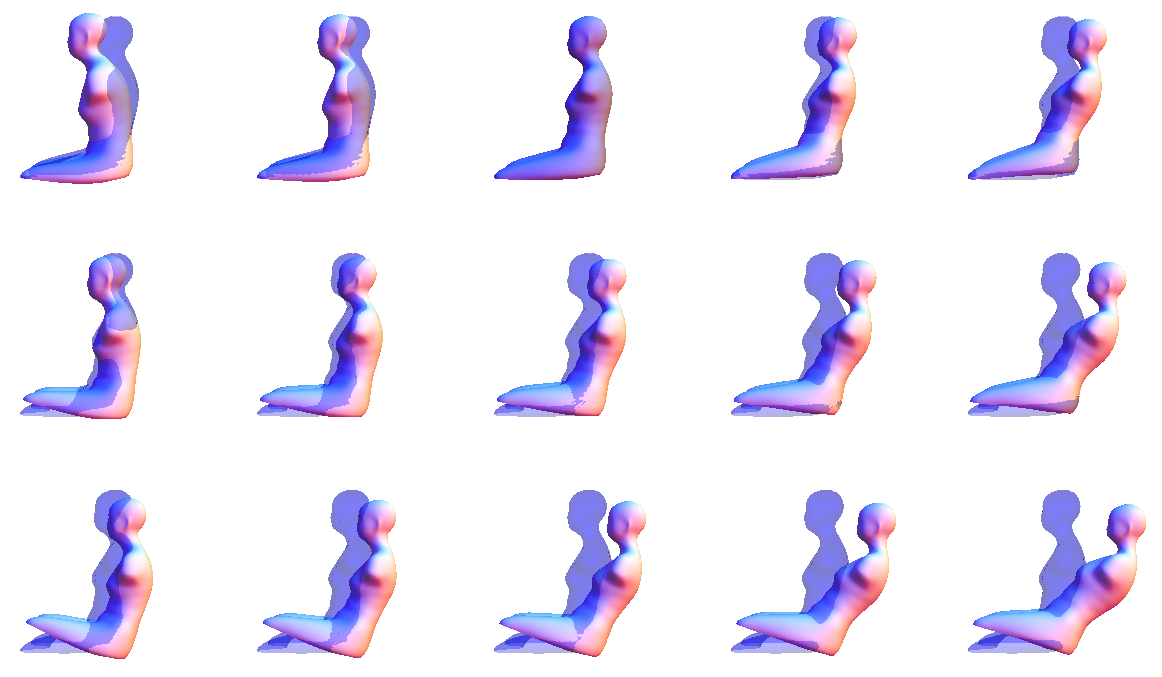
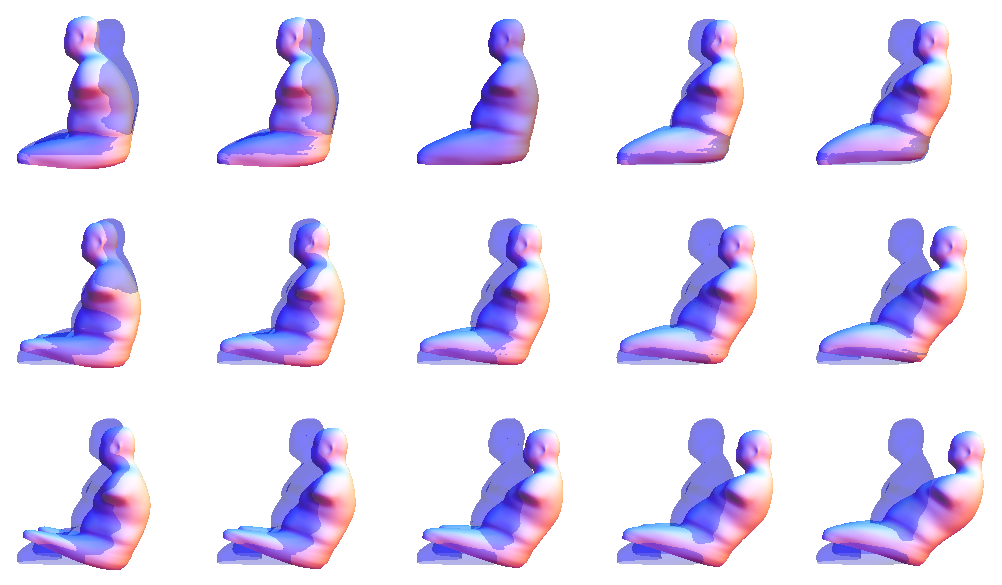
Whole-Body Laser Scanning Facility at UMTRI
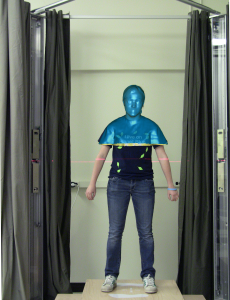
The Biosiences Group at UMTRI uses a whole-body laser scanner, the VITUS XXL, for body surface anthropometry research. The VITUS XXL records hundreds of thousands of data points on the surface of the body in about 12 seconds by sweeping four lasers vertically. The two cameras on each of the four scanning heads pick up the laser light contour projected on the subject and translate the images into accurate three-dimensional data.
Our primary application of the scanner is the study of body shapes in supported seated postures. Previous whole-body laser scanning studies have focused on the easier-to-scan standing and unsupported seated postures, but the results are difficult to apply to the design of seating. Our major emphasis is on the development of models to predict seated body shape and posture for crash safety applications, including the development of advanced crash dummies and computational models of vehicle occupants.
Surface Anthropometry of Children
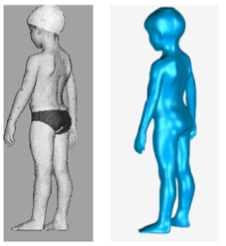
We are applying the scanning methodology to the study of seated posture and body shape in children. The figure below shows a typical seated posture for a 6YO child. This posture, and the resulting body shape, is substantially different from the erect postures in which most anthropometric data are gathered.
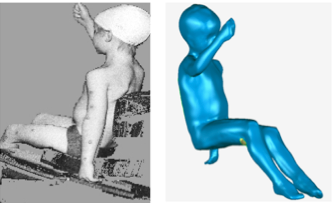
We have developed specialized scanning techniques for these challenging postures and subjects. We combine data gathered with the VITUS XXL whole-body scanner with data from a handheld scanner (FARO Technologies) that covers body regions shadowed from the whole-body scanner (for example, between the thighs). We also record skeletal landmark locations using both manual digitizing (FARO Arm) and visual identification on the scan data.
The outcome of this research is detailed models of child body shape that have wide application to safety, product design, protective equipment, and apparel. We are able to combine this new surface anthropometry data with our data on child postures, earlier large-scale traditional anthropometric surveys of children, and up-to-date, nationally representative samples of basic body dimensions to address many pediatric anthropometric design and ergonomics issues.
Adult Whole-Body Surface Anthropometry Model: Segmented Version
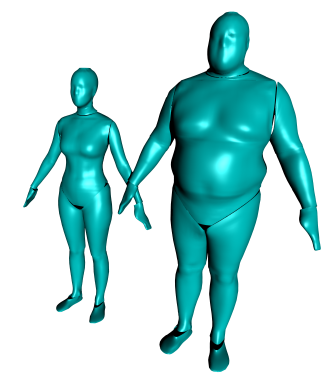
As part of our anthropometry research program, we have developed a whole-body, three-dimensional surface prediction model based on the CAESAR database. The entire North American sample (2400 adults) was segmented and surfaced using custom automated software. After quality control checks, scans from 983 men and 1023 women were analyzed to develop a unified model to predict body surface geometry, surface landmark locations, and internal skeletal joint lcoations.
The model can be exercised using whole-body target dimensions, such as stature and body weight, but many other possibilities are also available. For example, the figures below show the results of holding stature and BMI constant while manipulating torso shape parameters. People with the same BMI can have very different body shapes. For both men, the primary differentiator is chest muscle mass vs. abdominal fat. For women, torso body shapes differ primarily in patterns of fat deposition.
Importantly, this parametric model allows the creation of virtual populations that represent the U.S. population of body shapes better than the raw CAESAR sample. My colleagues and I have developed methods to use nationally representative data from the U.S. National Health and Nutrition Examination Survey (NHANES) to reweight databases such as CAESAR to represent target populations. The target population data can then be used to create either representative or boundary cases in three dimensions.
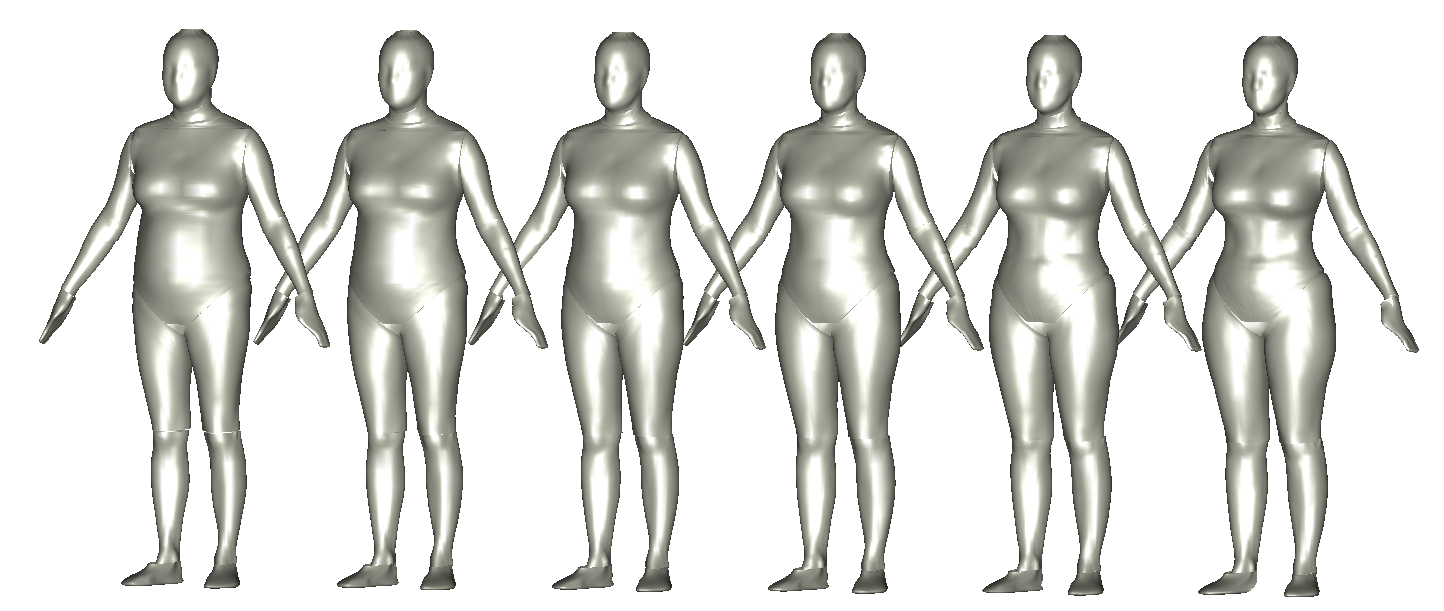
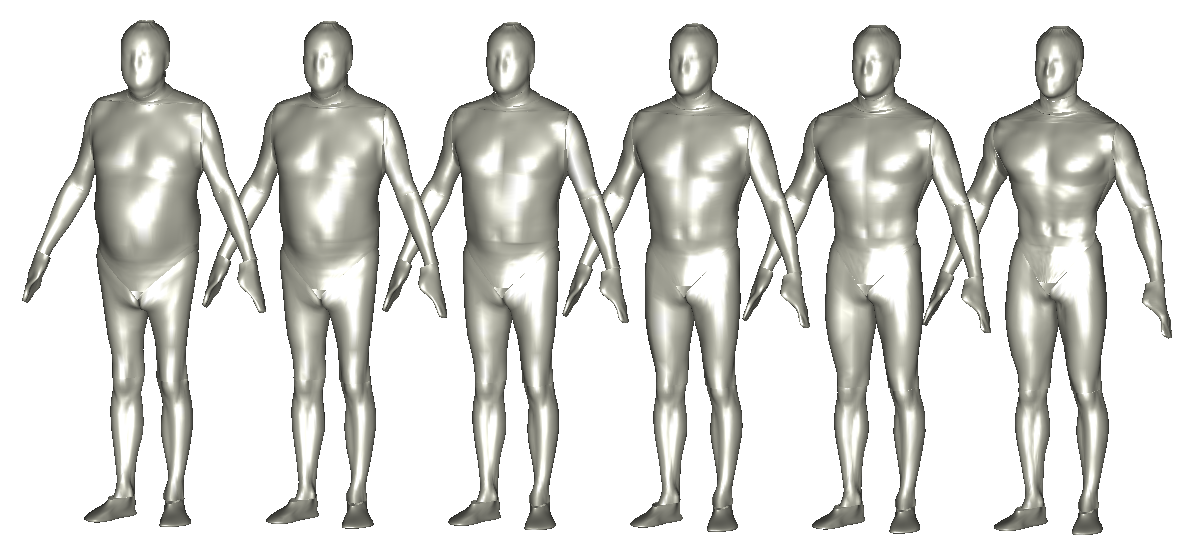
Body Shape Modeling: Ancient History
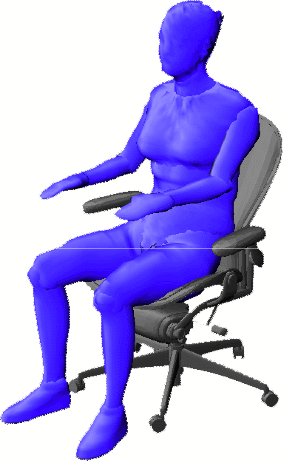
I have been using 3D body shape data in my research since 2000, drawing on the U.S. CAESAR body shape dataset. The image to the right is based on research I did in 2000-2001 using data from the U.S. CAESAR project. We published a paper at the Human Factors and Ergonomics Society annual meeting describing an automated method for segmenting standing scans, fitting the segments with polygonal meshes, and articulating the segments to achieve alternative postures. Many similar studies from other groups have since appeared in the literature. The primary weakness of our early methods, which we've since addressed, was that the posture change methods did not produce realistic, smooth contours at the joints. This early work also did not include the parametric modeling capability of our later models, but it was important early step in using scan data for engineering anthropometry.
©2024 Matthew P. Reed and The University of Michigan